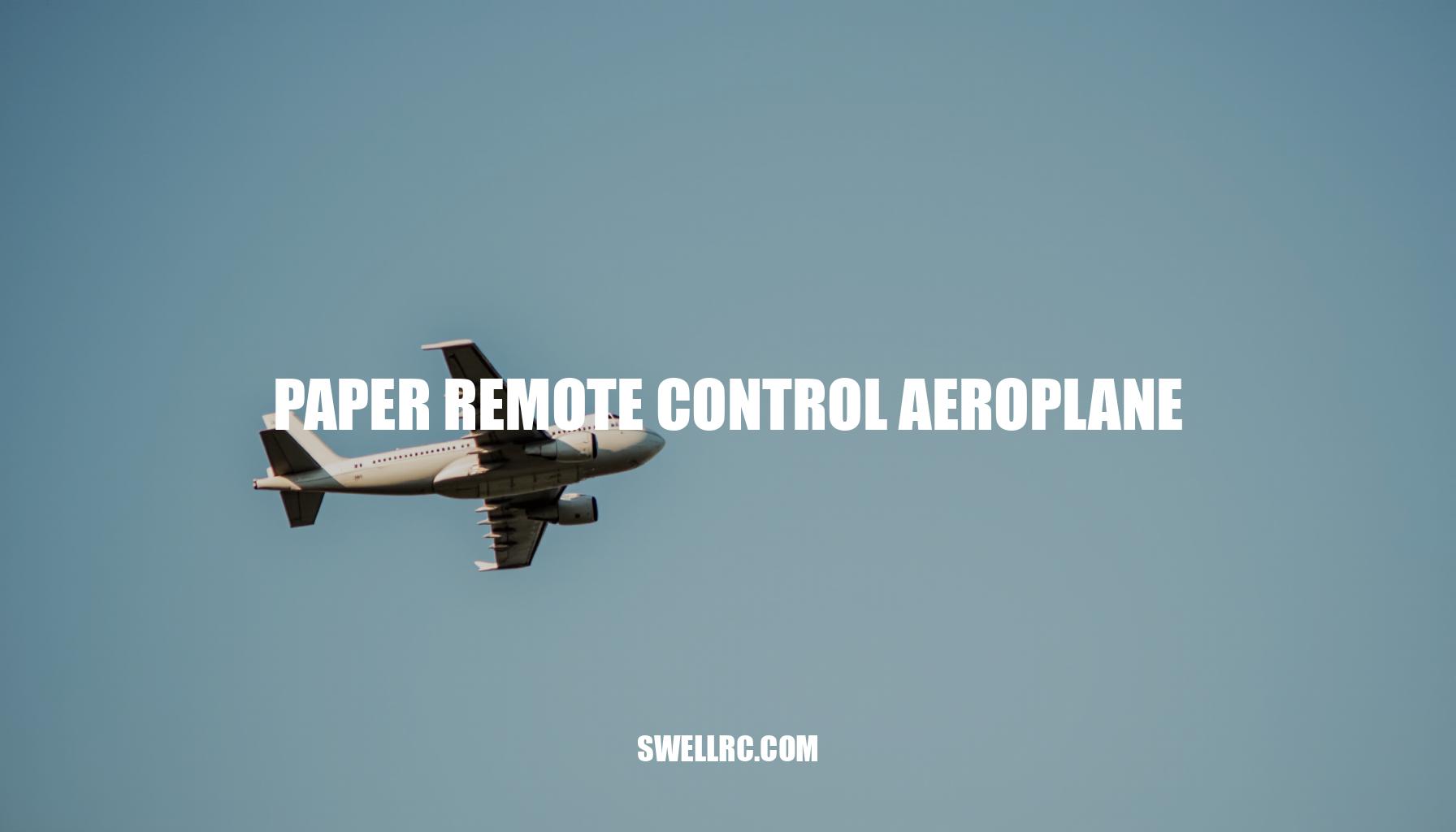Designing and Flying Your Paper Remote Control Aeroplane
When I first heard about paper remote control aeroplane projects, I thought it was just a gimmick—until I built one myself, gently tossed it into a gym, and watched as it climbed smoothly under precise radio control. The responsiveness of this lightweight paper model aeroplane once airborne completely surprised me! These innovative models are crafted from paper, thoughtfully reinforced to support tiny motors, servos, and batteries, making them a fantastic entry point for anyone interested in RC plane building.
They not only allow for quick prototyping but also offer thrilling flight experiences and valuable hands-on learning. For a quick overview of what’s achievable in this exciting niche of DIY RC flying toys, check out some inspiring RC Paper Aeroplane examples. In this comprehensive guide, I’ll walk you through the fundamental principles of remote control aircraft design, review the key components that really work, provide a detailed step-by-step build process, share essential flight tips, and explore where this accessible hobby is headed in the near future.
The Engineering Magic Behind Paper RC Planes
Paper can fly under RC control because it’s incredibly light—and with the right reinforcements, surprisingly stiff. I’ve had the best results mixing 80–120 gsm bond paper or light cardstock with 1–2 mm carbon fiber rods or strips. The key is balancing stiffness (to hold trim and resist flutter) with weight (to keep wing loading low).
Aerodynamically, you want a generous wing area, a clean thrust line, and control surfaces that don’t flex under load. Tiny changes to center of gravity (CG) matter—a 2–3 mm battery shift can turn a porpoising mess into a smooth cruiser. Understanding the aerodynamics of lightweight aircraft helps optimize weight distribution and thrust-to-weight ratio, both critical for stable flight.
When comparing material options, here’s a mini comparison table highlighting weight per area, ease of shaping, crash durability, repairability, and cost—key factors influencing foldable airplane structures and overall performance (including wing loading):
| Material | Weight per Area | Ease of Shaping | Crash Durability | Repairability | Cost |
|---|---|---|---|---|---|
| Paper | Very Low (80–120 gsm) | High | Low | High (easy to patch) | Very Low |
| Foam | Low | Medium | High | Medium | Medium |
| Balsa | Low-Medium | Low (requires skill) | Medium | Low (hard to repair) | High |
In summary, paper wins on speed of iteration and cost, making it ideal for rapid prototyping of foldable airplane structures. Foam leads in durability and waterproofing, suitable for outdoor flying or beginner flyers. Balsa offers the best stiffness-to-weight ratio but requires more advanced craftsmanship.
For a contrasting approach, check out lightweight foam jets like the KT RC Foam Aircraft Fighter Drone Jet.
From my tests, laminating only the high-stress zones (nose, spar, servo mounts) keeps weight low while effectively taming wing flutter and preventing nose dents, critical for maintaining a clean thrust line and optimal thrust-to-weight ratio. These small adjustments to the weight distribution and structural stiffness dramatically improve the flying characteristics and overall durability of paper-based RC planes.
Essential Components: Power, Control, and Balance
Here’s the compact electronics stack I rely on, explained in beginner-friendly terms:
- Micro motor: Choose a 6–8.5 mm coreless brushed motor, or for more punch, an ultra-micro brushless motor like the 1102. These lightweight motor systems are perfect for maintaining a low overall weight.
- Propeller: Use a 3–4 inch propeller matched to your motor to ensure efficient static thrust, which helps your plane fly smoothly and responsively.
- ESC or integrated flight receiver: Many ultra-micro boards integrate the ESC with the flight receiver to save precious grams, a crucial consideration when working with electric plane kits.
- Receiver: Opt for a 4–6 channel, sub-1 g receiver if possible, compatible with your radio transmitter for RC planes. This keeps your system lightweight yet functional.
- Servos: Use 1.3–2.5 g micro servos for paper planes, either conventional or linear, for controlling elevator and rudder, or ailerons if using a 3-channel setup. From experience, a lighter 1.5 g servo significantly reduces tail-heaviness compared to heavier options, improving trim and flight times.
- Battery: A 1S LiPo battery with 150–300 mAh capacity provides about 5–10 minutes of mixed throttle flight time.
- Transmitter: Any reliable RC radio transmitter with fine endpoint and expo adjustments works well, ensuring precise control.
| Component | Weight Range (g) |
|---|---|
| Motor | 2–6 g |
| Two servos | 3–5 g |
| Receiver/ESC | 1–4 g |
| 1S LiPo | 4–8 g |
| Airframe | 6–15 g |
Keep your flying weight under approximately 35–50 g for gentle indoor flying, while weights up to about 80 g can handle light outdoor conditions. Exploring helicopter components, such as those found at Exceed Remote Control Helicopter, can spark ideas for lightweight parts that fit your build. For inspiration on compact jet-style layouts and control mixing, check out the RC F-35 model at SwellRC RC F-35.
Building and Assembling a Paper Remote Control Aeroplane: My Step-by-Step Process
In my latest successful RC plane building project, I followed a detailed step-by-step process showcasing expert techniques in how to make a paper plane with remote control capabilities. The key stages included:
- Design and fold the fuselage: I began by sketching a top view featuring a straight thrust line, a generous wing, and a flat tail plane. Employing foldable airplane structures, I folded carefully to maintain perfect symmetry, which is crucial for stable flight.
- Reinforce weak points: To ensure durability while minimizing weight — essential aspects of best materials for a remote control paper plane — I integrated a carbon rod spar across the wing, added a small strip along the fuselage spine, and applied tiny cardstock doublers for servo mounts and the nose.
- Dry fit electronics: Before final assembly, I taped in the motor, receiver, and servos to verify balance.
Proper placement of the battery is vital; I aimed for the center of gravity (CG) to sit 20–30% back from the wing’s leading edge to optimize flight dynamics.
- Linkages and throws: Using light pushrods made from 0.5–0.8 mm wire or carbon, I kept control throws modest initially (±8–10 degrees), reflecting best practices in RC plane building.
- Final weigh-in and trim: The all-up weight was kept as low as possible to enhance performance, and precision ensured everything remained square for smooth control.
Throughout the build, I relied on visual placeholders such as a top-view plan with the CG marked, a side-view motor mount, and a servo horn direction diagram to guide accurate assembly. For those eager to dive deeper into advanced weight-saving techniques indoors, refer to How to Make Super Light RC Indoor Planes.
Initially, my model nosedived at takeoff due to a nose-heavy CG, but a simple adjustment—moving the battery back by 5 mm—transformed the flight into a smooth, controllable climb, demonstrating the critical importance of CG placement in RC plane building. This detailed process exemplifies how combining the right materials, precise folding techniques, and thoughtful electronics integration enables successful remote control paper plane construction.
Flying Techniques and Troubleshooting Common Issues
Before taking your lightweight RC aircraft to the skies, ensure you complete a thorough preflight checklist to optimize performance and extend battery life in lightweight RC aircraft. Key steps include setting your battery at storage-to-full voltage, performing a link and range test, verifying surface directions, reducing throws with 20–30% expo for smoother control, double-checking the center of gravity (CG), and ensuring the prop is tight and balanced.
During control setup and expo, especially for indoor versus outdoor environments, adjust your launch and control techniques accordingly. For indoor vs outdoor RC flying, indoors calls for a gentle, level toss at half throttle, while outdoors benefits from a slightly nose-up toss into the breeze.
Keep control inputs minimal as small airframes respond quickly.
Addressing common issues promptly will enhance flight stability. Here are frequent problems and quick fixes for effective troubleshooting RC planes:
- Instability/porpoising: Move the CG forward 2–3 mm, reduce elevator throw, and add a touch of downthrust.
- Roll drift: Ensure wing symmetry, add a thin tape trim tab, or adjust aileron subtrim.
- Control lag: Check for linkage slop, tighten hinges, and confirm proper receiver (RX) antenna placement.
- Battery sag/short flights: Use a fresh 1S LiPo battery, lower prop load, or reduce overall weight.
- Flutter/buzzing: Increase spar stiffness or slightly reduce control surface area.
Remember, indoor environments are ideal for initial flights and tuning, while outdoor conditions demand calmer air (under 5–7 mph wind) and slightly heavier models for enhanced stability. Drawing from rotorcraft troubleshooting tips, like those from the Double Horse 9101 helicopter, can provide valuable insights for tail authority and gyro-like stability.
As you gain experience, continue refining your control setup and expo and try exploring new models by browsing resources such as Pilot RC Planes.
Every adjustment you make teaches you more about your aircraft’s unique handling and helps you master both indoor and outdoor flying conditions.
Why Paper RC Planes Might Be the Future of Accessible Flight Design
Paper RC aircraft hit a sweet spot of creativity, affordability, and sustainable RC design. You can prototype a new wing in minutes, repair damage with a fresh fold, and keep material costs ultra-low, making it an ideal choice for those passionate about eco-friendly materials. This agility fuels learning and experimentation—especially for students and makers eager to explore accessible flight opportunities.
For enthusiasts who appreciate renewable, repairable materials, balsa wood remains a classic parallel. Its lightweight nature and sustainability make it a favorite alongside paper in many DIY RC communities.
Meanwhile, advancements in modern radio systems and microelectronics have continually pushed the boundaries, making components smaller, more capable, and easier to use. This evolution significantly lowers the barrier to entry for newcomers and hobbyists alike. If you’re exploring options, consider starting with a comparison of transmitters and ready-to-fly kits to find what best suits your goals.
The bigger picture is truly exciting: these DIY RC communities are blending art with aerospace by using simple, sustainable materials to experiment with control laws, airfoil tweaks, and even semi-autonomous features. Their work stands as proof that innovation in remote control aviation doesn’t have to come with a hefty price tag.
Conclusion: The Joy of Making It Fly
There’s nothing quite like the moment your handmade paper remote control aeroplane lifts off and tracks smoothly across a gym—equal parts engineering and magic. We’ve covered the aerodynamic basics, the minimalist electronics that work, a build flow you can follow, and the tweaks that turn wobbly flights into confident cruises. If you’re craving something creative for your next project, don’t miss the Flying Superman RC Plane for pure fun.
Whether you keep iterating on paper designs or step up to foam and balsa kits, you’re entering a world of DIY RC flying toys that fuels curiosity and skill development. Some key tips to enhance your experience include:
- Build light to maximize flight time and control.
- Trim carefully to ensure smooth, balanced flights.
- Explore remote control aircraft design fundamentals to improve performance.
For beginners, beginner RC planes and electric plane kits offer an accessible entry point with reliable builds and easy-to-follow instructions. As you gain confidence, moving from simple paper planes to more advanced kits will unlock endless flying fun and learning opportunities.
| Type of RC Plane | Ideal For | Key Feature |
|---|---|---|
| Paper RC Flying Toys | Creative DIY enthusiasts | Lightweight and customizable designs |
| Beginner RC Planes | New pilots and hobbyists | Simple controls and forgiving flight characteristics |
| Electric Plane Kits | Intermediate builders | Integrated power systems for easy assembly |
Enjoy the freedom of flight and let your curiosity guide each build and flight session. With DIY RC flying toys, every flight is a new adventure!
Frequently Asked Questions
- Can you really build a remote-controlled paper aeroplane?
Yes. With lightweight components (micro motor, 1–2 micro servos, 1S LiPo, tiny receiver), a reinforced paper airframe can fly under full RC control. Careful CG placement and minimal weight are the keys. - What parts do you need to make a paper RC plane fly?
A micro power system (motor and prop), ESC or integrated receiver, 1–2 micro servos, a 1S LiPo battery, and a compatible transmitter. Carbon fiber or cardstock reinforcements help the paper structure carry the load. - How far can a paper RC plane actually fly?
Range depends on your radio system and environment. With common micro receivers, expect reliable control within 50–200 meters line-of-sight. Indoors or in crowded RF spaces, practical range is shorter. - Which is better for beginners: foam or paper RC planes?
Foam is more durable and weather-resistant, making it forgiving outdoors. Paper is cheaper, faster to prototype, and great for indoor learning. Start with paper indoors, then try foam once you’re comfortable. - How do you control an RC paper plane mid-air?
Use small, smooth inputs. Set modest control throws with some expo, keep speed up to maintain stability, and trim CG precisely. Minor battery shifts and subtrim adjustments make a big difference. - Are there kits available for building paper RC planes?
Yes. You’ll find ultra-micro electronics bundles and paper/foam templates, plus ready-to-fly and almost-ready-to-fly options. Kits reduce guesswork on weight, balance, and part compatibility.



